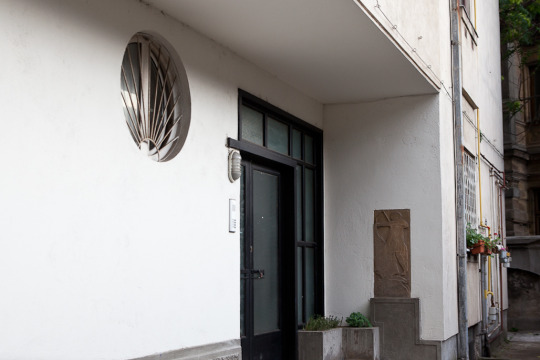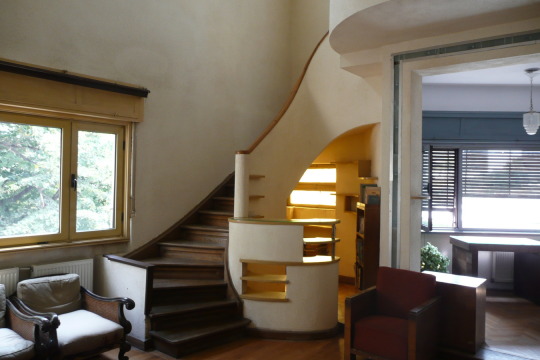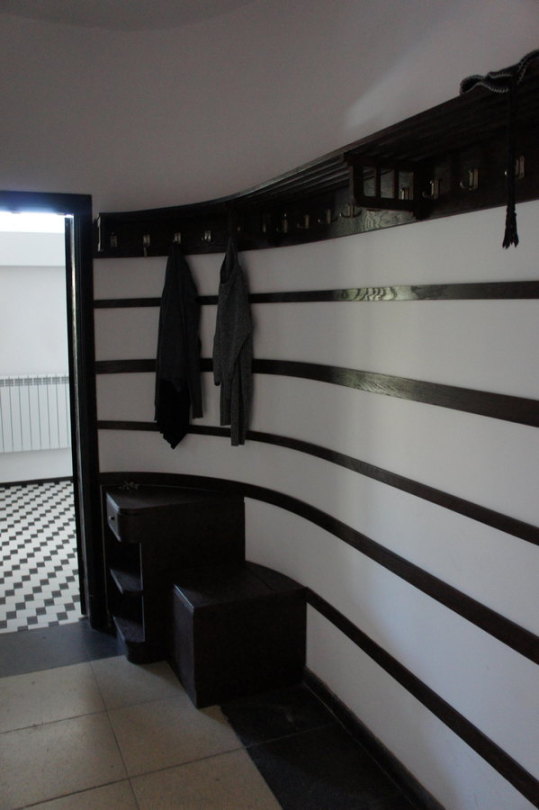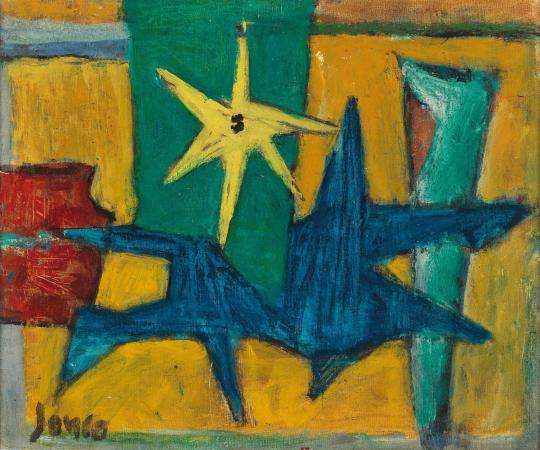#marcel janco
Explore tagged Tumblr posts
Text

Marcel Janco (Attributed to) - Horah
23 notes
·
View notes
Text





Intérieur de la Villa Solly Gold, Bucarest, Roumanie. Architecte : Marcel Janco 1934. Crédit photo : Marius Marcu Lăpădat, Mihai Caranică, Crisanta Măciuceanu. - source Cristina Ardelean via Art Deco.
32 notes
·
View notes
Text









Jean Arp, Illustrations for Tristan Tzara's "'Vingt-cinq poèmes", 1918
Marcel Janco, Portrait of Tristan Tzara, 1919 (center)
#jean arp#hans arp#tristan tzara#dada#dadaism#dadaist#german art#german artist#abstract#abstraction#abstract art#abstract artist#dada poetry#poetry#romanian poetry#romanian artist#romanian art#modern art#art history#aesthetictumblr#tumblraesthetic#tumblrpic#tumblrpictures#tumblr art#aesthetic#marcel janco#portrait
4 notes
·
View notes
Text

Daily Painting
Marcel Janco BALL IN ZURICH (1917)
0 notes
Photo
"Thanks for the Dadaist pep talk. I feel much more abstract now."




Cabaret Voltaire [Hugo Ball, Emmy Hennings, Tristan Tzara, Marcel Janco, Jean Arp, Richard Huelsenbeck]; Zurich, Switzerland, 1916.
#Cabaret Voltaire#Dadaism#Zurich#Dada#Sophie Taeuber-Arp#Tristan Tzara#Switzerland#Hugo Ball#Marcel Janco#Emmy Hennings#Richard Huelsenbeck#Jean Arp#Hannah Höch#Voltaire#magictransistor
689 notes
·
View notes
Text
youtube
If asked to explain the art movement known as Dada, I’d feel tempted to quote Louis Armstrong on the music movement known as jazz: “Man, if you have to ask, you’ll never know.” But maybe I’d do better to sit them down in front of the half-hour documentary The ABCs of Dada. They may still come away confused, but not quite so deeply as before — or maybe they’ll feel more confused, but in an enriched way.
Even the video, which gets pretty thorough about the origins of and contributors to Dada, quotes heavily from the relevant Wikipedia article in its description, framing the movement as “a protest against the barbarism of World War I, the bourgeois interests that Dada adherents believed inspired the war, and what they believed was an oppressive intellectual rigidity in both art and everyday society.” They came to the conclusion that “reason and logic had led people into the horrors of war, so the only route to salvation was to reject logic and embrace anarchy and irrationality.” So there you have it; don’t try to understand.
Perhaps you remember that vintage Onion article, “Republicans, Dadaists Declare War on Art,” satirizing, among other things, the way proponents of Dada called its fruit not art, but “anti-art.” They made it deliberately meaningless where “real” art strove to deliver messages, deliberately offensive where it strained to appeal to common sensibilities. The ABCs of Dada examines Dada through a great many of these Dadaists themselves, such as Sophie Taeuber-Arp, a teacher and dancer forced to wear a mask for her Dada activities due to the group’s scandalous reputation in the academy; architect Marcel Janco, who remembers of the group that “among us were neither blasé people nor cynics, actors nor anarchists who took the Dada scandal seriously”; and “Dada-marshal” George Grosz, who declared that “if one calls my work art depends on whether one believes that the future belongs to the working class.” You can find further clarification among UBUweb’s collection of Dada, Surrealism, & De Stijl Magazines, such as Zurich’s Cabaret Voltaire and Berlin’s Der Dada. Or perhaps you’ll find further obfuscation, but that aligns with the Dada spirit — in a world that has ceased to make sense, so the Dadaists believed, the duty falls to you to make even less.
Source: https://www.openculture.com/2014/08/the-abcs-of-dada.html
10 notes
·
View notes
Text

The weekly sculpture corner
A couple in a sardine can
Ein Hod
Ein Hod is a village in Haifa District in northern Israel. Located at the foot of Mount Carmel and southeast of Haifa,
Ein Hod became an artists' colony in 1953. The driving spirit behind the project was Marcel Janco, an acclaimed Dada artist, who kept the village from being demolished by the security forces and convinced the government to let him build an artists' colony there
Photo by :
Odelia ben Hemo
5 notes
·
View notes
Text
Marcel Janco, “Ball in Zurich”, 1917

3 notes
·
View notes
Photo
costume by Arp, mask by Janco

Sophie Taeuber-Arp dancing with a mask by Marcel Jonco, most likely at the Cabaret Voltaire, Zürich, 1916-1917
45 notes
·
View notes
Text

Marcel Janco, Relief au miroir, 1916 - 1917
4 notes
·
View notes
Text
O "Grande Vidro" de Marcel Duchamp e Dadaísmo - Parte 1
HISTÓRIA - Dadaísmo

O dadaísmo foi um movimento artístico e cultural que surgiu em 1916, em Zurique, no contexto da Primeira Guerra Mundial, como uma reação à destruição e ao irracionalismo da guerra. Seus fundadores, como Hugo Ball, Tristan Tzara, Jean Arp e Marcel Janco, reuniram-se no Cabaret Voltaire, um espaço dedicado à experimentação artística e à performance.
O movimento rejeitava as convenções da arte tradicional, questionando as noções de lógica, razão e beleza que, segundo os dadaístas, haviam contribuído para os horrores da guerra. O nome "Dada" foi escolhido aleatoriamente por Tzara, refletindo a ideia de um movimento sem regras ou sentido.
Os dadaístas exploraram a irreverência, o absurdo e o caos, criando obras que desafiavam a estética convencional, como colagens, poemas fonéticos e "readymades". O dadaísmo não se limitou à arte visual; também influenciou a literatura, o teatro, a música e a performance.
Apesar de sua curta duração, o dadaísmo teve um impacto duradouro, influenciando movimentos posteriores como o surrealismo e a arte contemporânea, além de expandir as possibilidades da expressão artística no século XX.
Influência
O dadaísmo teve uma influência importante no Brasil nas décadas de 1920 e 1930, especialmente no contexto do Modernismo e do Movimento Antropofágico. Artistas como Oswald de Andrade e Tarsila do Amaral incorporaram a atitude irreverente e experimental do dadaísmo, desafiando as convenções artísticas e culturais da época. O movimento no Brasil, embora não uma réplica do dadaísmo europeu, compartilhou a busca por novas formas de expressão, valorizando o absurdo, a subversão e a crítica à tradição, o que ajudou a fomentar a inovação na arte e na literatura brasileiras.
1 note
·
View note
Text
Reading 2: DADA & Photomontage
DADA was an avant-garde movement that emerged as a negative reaction to the horrors and absurdities of World War I. It was characterized by its rejection of the traditional values and norms of art and society, aiming to devalue established conventions through irrationality and nonsense.
DADA was rooted in the neutral environment of Switzerland but quickly grew into an international movement. DADA was anti-war, anti-bourgeois, and anti-art, embodying a state of mind rather than a specific style. It was an uprising against the cultural and intellectual conformity that had led to the war, emphasizing spontaneity, nonsense, and the irrational.
DADA artists expressed their ideas through various means, including absurd performances, irrational and fragmented poetry, and art that defied traditional aesthetics and meaning. Their works often involved satire, parody, and a deliberate embrace of chaos and randomness to challenge the existing social and artistic norms.
DADA's influence is evident in various modern and contemporary art forms, particularly in surrealism, performance, and conceptual art. The movement's legacy persists in the modern art world, where artists continue to explore themes of absurdity, challenge conventional aesthetics, and push the boundaries of what art can be.
Tristan Tzara, a founding figure of DADA, was known for his provocative poetry and manifestos that articulated the movement's anti-establishment ethos. Marcel Janco's chaotic and fragmented paintings and architecture embodied DADA's aesthetic. Hugo Ball, a poet and performer, was instrumental in founding DADA and establishing its theatrical and performative aspects through his elaborate sound poem recitations. Jean Arp's abstract sculptures and collages exemplified DADA's embrace of chance and irrationality. Hannah Höch pioneered photomontage, creating provocative and surreal collages that critiqued contemporary society and gender norms. Raoul Hausmann, a key figure in the Berlin DADA group, innovatively used photomontage to critique media and political propaganda. Marcel Duchamp's ready-mades, such as "Fountain," radically redefined art and challenged the notion of artistic authorship and creativity.
DADA artists, particularly through the use of photomontage, redefined the role and potential of photography. Hannah Höch and others used this technique to create new, surreal images by cutting and reassembling photographs. This method challenged the idea of photography as a mere tool for documentation and opened up new avenues for creative and critical expression. Their work demonstrated that photographs could be manipulated to convey complex and provocative messages, breaking away from traditional notions of visual representation.
0 notes
Text
I ribelli del Dadaismo: un viaggio tra ironia e nichilismo
Il Dadaismo, nato durante la Prima Guerra Mondiale come reazione all'orrore e all'assurdità del conflitto, sconvolse il panorama artistico del XX secolo. Artisti provenienti da diverse discipline si unirono sotto l'egida di un'unica parola, "Dada", che in romeno significa "si", "no" e "bambino". Un'ironia intrinseca che permeava ogni loro opera, volta a sovvertire le convenzioni artistiche e a mettere in discussione il concetto stesso di arte. Zurigo, Cabaret Voltaire e la nascita del movimento Nel 1916, a Zurigo, un gruppo di artisti e intellettuali, tra cui Hugo Ball, Emmy Hennings, Tristan Tzara, Hans Arp e Marcel Janco, si rifugiò dalla guerra. Incontrandosi al Cabaret Voltaire, diedero vita al Dadaismo. Le loro serate erano un mix di performance caotiche, poesia fonetica, musica atonale e arte visiva provocatoria. L'obiettivo era quello di creare un'arte anti-arte, che distruggesse i valori borghesi e celebrasse l'irrazionalità. Dada a New York e Parigi Il movimento si diffuse rapidamente in altre città, come New York e Parigi. A New York, Marcel Duchamp scandalizzò il mondo dell'arte con i suoi "ready-made", oggetti quotidiani elevati a opere d'arte per il semplice fatto di essere stati scelti dall'artista. Man Ray, con i suoi fotogrammi e le sue opere surrealiste, contribuì a dare al Dadaismo americano una sua identità specifica. A Parigi, Francis Picabia con le sue riviste e i suoi dipinti satirici, e Sophie Taeuber-Arp con le sue opere astratte e i suoi dada-textiles, alimentarono la vena polemica e iconoclasta del movimento. Tecniche e linguaggi del Dadaismo I dadaisti utilizzarono una varietà di tecniche e linguaggi per esprimere la loro disillusione e il loro nichilismo. Il collage, il fotomontaggio, l'assemblaggio di oggetti trovati e l'utilizzo di materiali inusuali erano all'ordine del giorno. La poesia dadaista era spesso nonsense, fatta di suoni e parole senza senso, che rifletteva il caos e l'assurdità del mondo circostante. Eredità del Dadaismo Il Dadaismo, pur essendo durato solo un decennio, ha avuto un'influenza enorme sull'arte moderna. Il suo spirito di ribellione e di sperimentazione ha aperto la strada a movimenti successivi come il Surrealismo e l'Arte Concettuale. L'ironia dissacrante e il rifiuto delle convenzioni borghesi continuano a ispirare artisti e creativi ancora oggi. Oltre ai nomi già citati, altri artisti dadaisti di rilievo includono: - Hans Richter (Germania) - Kurt Schwitters (Germania) - Hannah Höch (Germania) - Beatriz Hastings (Inghilterra) - Marcel Janco (Romania) - Francis Picabia (Francia) - Man Ray (Stati Uniti) Foto di Robert Nilsson da Pixabay Read the full article
0 notes


